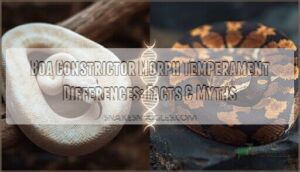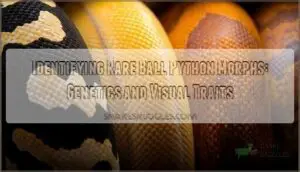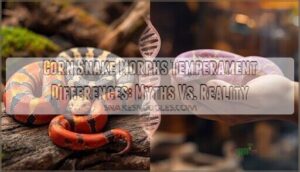This site is supported by our readers. We may earn a commission, at no cost to you, if you purchase through links.

Neurotoxic venoms from cobras and mambas attack your nervous system, potentially causing paralysis. Hemotoxic venoms in vipers like rattlesnakes destroy blood cells and tissue.
Cytotoxic venoms found in some cobras break down cells at the bite site. Myotoxic venoms target muscle tissue.
Most venomous snakes actually combine multiple venom types – it’s nature’s cocktail approach to subduing prey. The deadly efficiency varies dramatically between species, with some requiring just micrograms to prove fatal while others need much larger doses to cause serious harm.
Table Of Contents
- Key Takeaways
- Snake Venom Types
- Venom Composition Variations
- Venomous Snake Families
- Venom Components Analysis
- Species Specific Venoms
- Frequently Asked Questions (FAQs)
- Do all snakes have the same type of venom?
- Which snake is both hemotoxic and neurotoxic?
- Which snake venom kills faster?
- Which snake venom is most potent?
- Which is worse, hemotoxic or neurotoxic venom?
- What are the four main types of venomous snake?
- What are the different levels of snake venom?
- Are all venomous snakes aggressive towards humans?
- How do snakes use their venom for hunting and defense?
- Can snake venom be used for recreational purposes?
- Conclusion
Key Takeaways
- You’ll encounter four main venom types that target different body systems: neurotoxic (nervous system paralysis), hemotoxic (blood and tissue destruction), cytotoxic (cell membrane breakdown), and myotoxic (muscle tissue damage).
- Most venomous snakes don’t rely on just one venom type – they’ve evolved deadly cocktail combinations that make them more effective hunters, with species like cobras mixing neurotoxic and hemotoxic components.
- Venom composition varies dramatically by species and geographic location due to evolutionary adaptations, meaning identical snake species can deliver completely different effects depending on where you encounter them.
- The four main venomous snake families each pack distinct chemical weapons: Elapidae (cobras, mambas) use neurotoxins, Viperidae (vipers, rattlesnakes) rely on hemotoxins, while sea snakes and some colubrids have their own specialized toxin profiles.
Snake Venom Types
You’ll encounter four main venom types when studying venomous snakes, each targeting different body systems with distinct lethal mechanisms.
Nature’s most lethal arsenal: four venom types, each a specialized weapon targeting your body’s vital systems.
These classifications help scientists and medical professionals understand how different species have evolved specialized toxins to subdue prey and defend against threats, which is crucial for understanding the lethal mechanisms.
Neurotoxic Venoms
Neurotoxic venom typically strikes the nervous system like a silent assassin, causing paralysis within minutes.
You’ll find this deadly cocktail in cobra venom and black mamba bites.
These venomous snake species deliver potent neurotoxins that block nerve signals, leading to respiratory failure.
Toxicology studies reveal how nerve damage occurs rapidly, making venom resistance essential for survival.
Hemotoxic Venoms
While neurotoxic venoms shut down your nervous system, hemotoxic venoms wage war on your blood and tissues.
These snake venom types destroy red blood cells through hemolysis mechanism, disrupting clotting and causing massive internal bleeding.
Venom delivery from venomous snake species like vipers creates toxic reactions that lead to organ failure.
Snake bites from hemotoxin venom cause cardiovascular collapse, making this snake venom composition particularly dangerous for survival.
Understanding the viper venom effects is essential in developing effective treatments for snakebites.
Cytotoxic Venoms
Cytotoxic venom strikes your body like a cellular sledgehammer, targeting tissues directly.
This venom classification causes severe cellular damage through cytotoxin venom compounds that destroy cell membranes.
Unlike neurotoxin venom affecting nerves or hemotoxin venom disrupting blood, cytotoxic effects create localized tissue death.
Venom potency varies among snake venom types, with toxicity levels determining cellular response severity and overall tissue damage extent.
Myotoxic Venoms
Myotoxic venoms pack a punch that’ll leave you paralyzed faster than you can say "sea snake."
These toxins target muscle fibers directly, causing instant paralysis and severe muscle damage.
Sea Snake Venom leads this deadly category, with toxicity levels that make other venom classification types look tame by comparison, due to its highly toxic nature.
Venom Composition Variations
You’ll find that venom composition varies dramatically between snake species based on their geographic location and evolutionary history.
These variations reflect millions of years of adaptation to specific prey types and environmental challenges, which is a result of their evolutionary history.
Geographic Variations
You’ll often discover snake venom types vary dramatically across geographic regions, creating distinct patterns that affect both prey and medical treatment.
Regional distribution shapes these deadly cocktails through evolutionary pressure.
Here’s how geographic variations impact snake venom classification:
- Desert Venoms: Arid-adapted species produce more neurotoxic compounds with reduced proteolytic activity
- Tropical Species: Rainforest snakes exhibit elevated cytotoxins for arboreal prey specialization
- Mountain Ecosystems: Highland vipers express increased metalloproteinases and hemorrhagic factors
- Island Habitats: Isolated populations develop unique toxin profiles through genetic drift
- Coastal Regions: Maritime venomous snakes show enhanced tissue-damaging components for local prey
These geographic variations mean identical species can deliver completely different envenomation effects depending on location.
Understanding geographic venom composition is essential for effective medical interventions and treatments.
Species-Specific Compositions
Each snake species has developed its own unique venom cocktail based on its prey preferences and hunting style.
You’ll find that Russell’s vipers pack hemotoxic punches perfect for small mammals, while cobras deliver neurotoxic blends that quickly paralyze birds.
These species-specific venom compositions reflect millions of years of fine-tuning, creating deadly toxins perfectly matched to each hunter’s needs.
Evolutionary Adaptations
Since you provided detailed evolutionary adaptations research, snake venom evolution represents nature’s arms race in action.
Your understanding of these deadly cocktails reveals fascinating survival strategies where genetic variations drive adaptive traits.
Through millions of years, venomous species developed specialized neurotoxic compounds targeting specific prey weaknesses.
This evolutionary dance continues today, with snake behavior constantly adapting as venom toxicity research reveals new mechanisms behind their lethal effectiveness.
The study of venom evolution patterns highlights the complex and dynamic nature of snake venom development over time, showing how it has evolved in a process that can be described as in fits and spurts.
Venomous Snake Families
You’ll find that venomous snakes belong to four main families, each with distinct toxic cocktails that have evolved over millions of years.
These families – Elapidae, Viperidae, Colubridae, and Hydrophiidae – pack different chemical punches that can shut down your nervous system, destroy your blood, or melt your tissues depending on which species crosses your path, with effects that can be extremely deadly.
Elapidae Family Venoms
Elapidae family snakes pack the most potent neurotoxic venoms you’ll encounter.
They are found in cobras, mambas, and coral snakes that evolved three-finger toxins targeting your nervous system with surgical precision.
Black Mamba venom can kill within thirty minutes, while over 90% of Elapidae species rely on neurotoxic compounds.
Their alpha-neurotoxins block acetylcholine receptors, causing flaccid paralysis.
Elapid evolution created venom resistance in some prey species, driving ongoing toxicology studies into these deadly cocktails.
The venom composition is influenced by nicotinic acetylcholine receptors in prey models, which is a key area of research in understanding the potency of venom.
Viperidae Family Venoms
Viper venom packs a hemotoxic punch that’ll make your blood run cold.
Unlike their elapid cousins, these pit vipers deliver cytotoxin venom that destroys tissues and disrupts clotting.
Here’s what makes viper venom so devastating:
- Rattlesnake bites cause massive internal bleeding and organ failure
- Pit viper enzymes break down blood vessels and muscle tissue
- Venom resistance remains virtually impossible due to complex protein cocktails
- Venom extraction reveals metalloproteinases that literally digest your insides
These snake venom effects turn victims into walking time bombs.
Reptile venom from vipers doesn’t just kill—it liquefies.
Colubridae Family Venoms
Most colubrids pack a mild punch compared to their deadly cousins.
You’ll find rear-fanged species like boomslangs and twig snakes deliver cytotoxin venom through grooved teeth, causing tissue damage and bleeding disorders.
Colubridae toxins rarely threaten humans due to inefficient delivery systems, though bites from larger species warrant medical attention.
Snake bites from this family seldom prove fatal, making toxicology studies focus on venom resistance mechanisms.
Hydrophiidae Family Venoms
Sea snakes pack deadly neurotoxic and myotoxic venoms that’ll shut down your nervous system fast.
These Hydrophiidae serpents evolved specialized Sea Snake Toxins for underwater hunting, targeting fish and eels.
You’re looking at instant muscular paralysis from their Marine Venom – that’s myotoxic action right there.
Their snake venom types include potent neurotoxins causing Snake Bite Symptoms like respiratory failure.
Hydrophiidae Evolution produced these lethal venomous animals through millions of years adapting to ocean life, though humans rarely encounter them.
The potency of their venom is influenced by complex marine adaptations that have developed over time.
Venom Components Analysis
When you’re examining snake venom, you’re looking at nature’s most sophisticated chemical weapons system.
The three main components – metalloproteinases that break down tissues, phospholipases that destroy cell membranes, and various enzymes that target specific body systems – work together like a perfectly coordinated attack squad.
Snake Venom Metalloproteinases
When you encounter snake venom metalloproteinases, you’re dealing with nature’s molecular scissors.
These enzymes slice through blood vessel walls like hot knives through butter, causing devastating hemorrhage.
Snake venom research shows P-III metalloproteinases pack the deadliest punch, while enzyme inhibition offers hope for snake venom antidote development in biochemical analysis studies.
Understanding the role of venom protein components is essential in the development of effective treatments.
Phospholipases in Venom
Phospholipase enzymes in snake venom act like molecular scissors, slicing through cell membranes with deadly precision.
You’ll find these venom enzymes performing essential biochemical roles, breaking down lipids that protect your cells.
Their toxic effects include destroying red blood cells, disrupting blood clotting, and triggering severe inflammation.
Different snake venom types contain varying phospholipase concentrations, making venom immunology research essential for developing effective antivenoms.
Understanding the role of copperhead venom enzymes is vital in the development of treatments for snakebites.
Enzymes and Toxins
Beyond the well-known phospholipases, snake venom contains dozens of specialized enzymes and toxic peptides that work like a sophisticated biochemical weapon.
These proteins trigger deadly molecular interactions through specific enzyme functions. Hyaluronidases act as "spreading factors," while metalloproteinases destroy tissue.
Anticoagulants prevent blood clotting, creating internal bleeding. Each toxin’s protein structure determines its lethal biochemical reactions within your body.
Researchers study venom components in relation to snake venom toxins to better understand their complex effects, including the role of metalloproteinases and how they contribute to the venom’s overall toxicity, making biochemical weapon a fitting description.
Species Specific Venoms
You’ll find that different snake species pack dramatically different chemical weapons in their venoms, each fine-tuned by evolution for their specific hunting needs and prey.
From the lightning-fast neurotoxins of mambas to the tissue-destroying cocktails of vipers, each species has developed its own deadly signature that reflects millions of years of predator-prey arms races.
Black Mamba Venom
Black Mamba venom packs a deadly punch with neurotoxic dendrotoxins that shut down your nervous system fast.
Just 10-15mg can kill an adult, yet these snakes inject up to 400mg per bite.
You’ll face respiratory paralysis within 20 minutes without antivenom.
Their cytotoxic and hemotoxic components destroy tissues while anticoagulants prevent clotting, making every second count.
The venom’s neurotoxic effects are particularly devastating, leading to rapid shutdown of the nervous system.
Inland Taipan Venom
You’ll find the inland taipan holds the record for venom potency among land snakes.
Its toxins pack an LD50 of just 0.025mg/kg, making it fifty times more lethal than cobra venom.
This Australian species delivers neurotoxic and hemotoxic compounds through short fangs, causing rapid paralysis and blood clotting failure.
Despite extreme toxicity levels, taipan habitat remoteness means human snake bites remain exceptionally rare.
Eastern Brown Snake Venom
Australia’s Eastern Brown Snake delivers a lethal cocktail through snake bites that’ll stop you in your tracks.
This brown snake species packs both neurotoxic and hemotoxic venom types, targeting your nervous system and blood simultaneously.
Venom effects include paralysis, cardiac arrest, and severe bleeding.
Toxicology studies reveal this snake venom contains powerful coagulants that disrupt clotting.
Venom research shows cytotoxic components destroy tissue at bite sites, making Eastern Browns among Australia’s deadliest snake species.
Coastal Taipan Venom
You’ll find the coastal taipan packs neurotoxic venom with extreme toxicity levels.
This Australian species delivers venom through efficient fangs in coastal habitat regions.
Taipan bites cause rapid paralysis and respiratory failure, and unlike some venomous snakes, humans show little venom resistance to these snake venom types.
Coastal taipans rank among the deadliest snakes globally, making snake venom therapy critical for survival after snake bites.
Frequently Asked Questions (FAQs)
Do all snakes have the same type of venom?
No, snakes don’t all have the same venom type.
You’ll find neurotoxic venom in cobras and mambas, hemotoxic in vipers and rattlesnakes, and cytotoxic in some species, each targeting different body systems.
Which snake is both hemotoxic and neurotoxic?
Ever wondered which serpent packs a double punch?
You’ll find cobras like the Indian cobra carry both neurotoxic and hemotoxic components in their venom, delivering paralysis and blood damage simultaneously for maximum hunting effectiveness.
Which snake venom kills faster?
Neurotoxic venom kills faster than hemotoxic venom. You’ll face death within thirty minutes from neurotoxic bites, while hemotoxic venom takes hours or days to cause fatal organ failure.
Which snake venom is most potent?
The inland taipan’s venom is most potent, with an LD50 of just 025mg/kg in mice.
You’d find this Australian snake’s neurotoxic cocktail incredibly deadly—theoretical lethal dose for humans is only 25mg.
Which is worse, hemotoxic or neurotoxic venom?
Both poisons are nature’s cruel weapons, but neurotoxic venom acts faster, shutting down your nervous system within minutes.
You’ll likely survive hemotoxic bites with medical care, while neurotoxic envenomation can kill you before help arrives.
What are the four main types of venomous snake?
You’ll encounter four main venomous snake categories: elapids like cobras and mambas with neurotoxic venom.
Vipers including rattlesnakes with hemotoxic venom, sea snakes carrying myotoxic venom, and rear-fanged colubrids with cytotoxic effects.
What are the different levels of snake venom?
Like a deadly cocktail with varying strengths, snake venom toxicity levels range dramatically.
You’ll encounter mild cytotoxic effects causing tissue damage, moderate hemotoxic venoms disrupting blood clotting, and severe neurotoxic varieties targeting your nervous system with potentially fatal results.
Are all venomous snakes aggressive towards humans?
No, most venomous snakes aren’t naturally aggressive toward humans.
They’re defensive creatures who’d rather escape than fight.
You’ll typically see bites happen when snakes feel cornered, surprised, or threatened.
They save their venom for prey, not people.
How do snakes use their venom for hunting and defense?
Snakes strike to kill prey, then digest meals efficiently.
You’ll find they defend themselves by striking predators too.
Their venom contains specialized proteins—neurotoxins paralyze victims while hemotoxins destroy blood cells, making hunting remarkably effective.
Can snake venom be used for recreational purposes?
No, you shouldn’t use snake venom recreationally.
It’s extremely dangerous and potentially fatal.
Venom contains complex toxins designed to kill prey – neurotoxins cause paralysis, hemotoxins destroy blood cells, and cytotoxins damage tissues, leading to severe poisoning or death.
Conclusion
Have you ever wondered why some snake bites cause paralysis while others destroy blood cells?
Understanding snake venom types by species reveals nature’s complex biochemical warfare. Each venomous snake has evolved specialized toxin combinations targeting specific prey systems.
Neurotoxic venoms shut down nervous systems, hemotoxic venoms destroy blood, cytotoxic venoms break down tissues, and myotoxic venoms target muscles.
This deadly diversity makes proper identification essential for effective treatment and survival in snake encounters.
- https://a-z-animals.com/animals/snake/snake-facts/4-types-of-snake-venom/
- https://www.frontiersin.org/journals/ecology-and-evolution/articles/10.3389/fevo.2019.00218/full
- https://zooatlanta.org/snake-venoms-and-myths/
- https://pmc.ncbi.nlm.nih.gov/articles/PMC551567/
- https://www.pnas.org/post/journal-club/snake-venom-evolved-in-fits-and-spurts
















